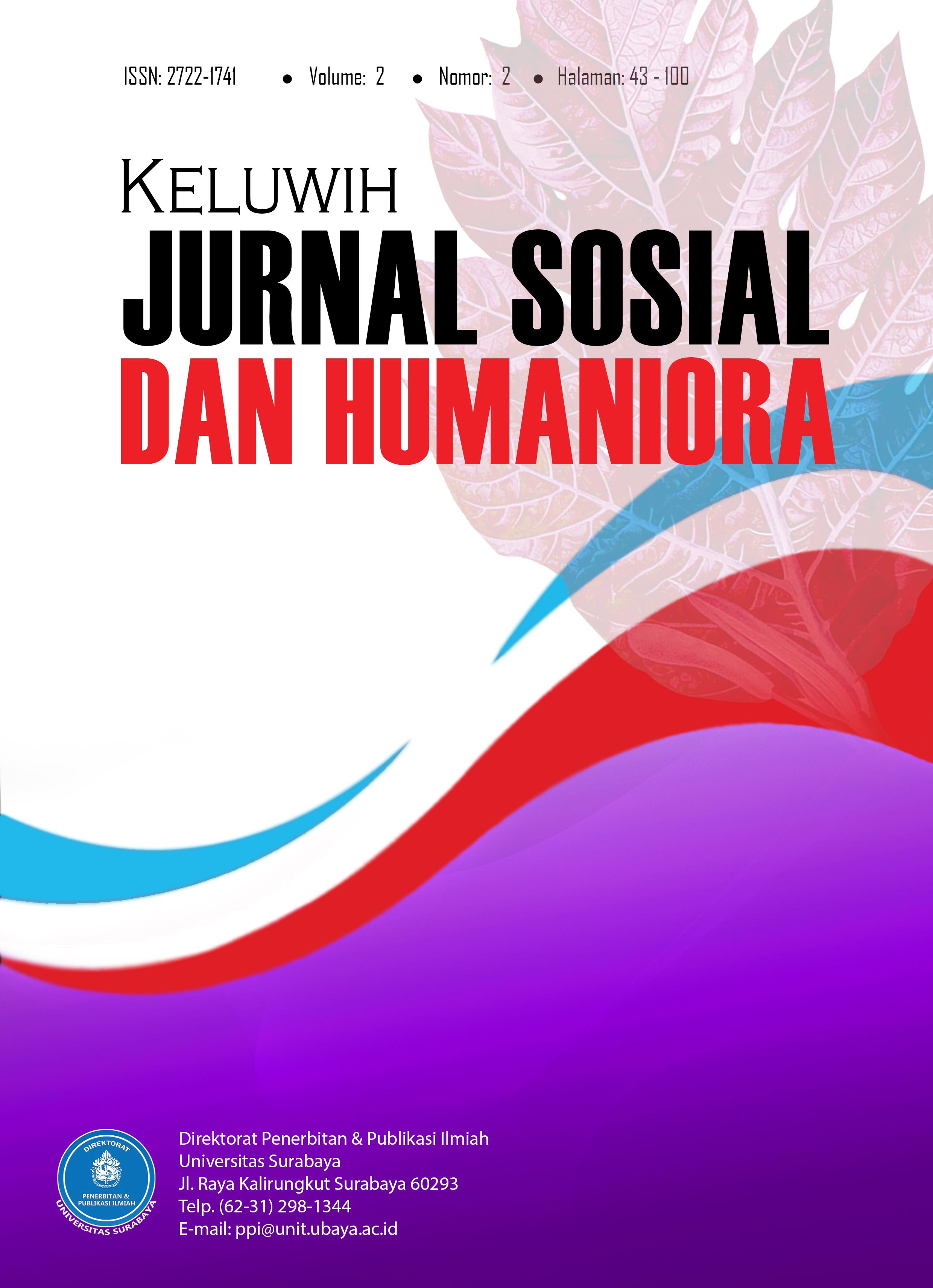Eroding online Violence Towards Indonesian Women During Covid-19
 Abstract Views:
483 times
Abstract Views:
483 times
 PDF Downloads:
448 times
PDF Downloads:
448 times
Abstract
Abstract—The coronavirus has fully motivated a number of regions in Indonesia to implement Large-Scale General Restrictions (PSBB). This policy may be the right solution. However, it also brings with it a recent dilemma embracing women. PSBB has influenced individuals to limit their physical mobility and move them to use high dependence on technology platforms including the web or social media. The intensity and repetition of social media use leads to online aggression compared to the case of women. The Jakarta Women's Legal Aid Institute noted that there were 30 cases of online violence against women in Indonesia in March and April 2020. Unfortunately, this number continues to increase from year to year. Many forms of online sex-based violence exist and most of them aim to intimidate, humiliate, and dominate women. Some of them are online sexual harassment, fear of sharing personal content with exploitation themes, dating violence, and online extortion. Surprisingly, not all women in Indonesia understand and report these forms of violence to the National Commission for the Protection of Women or related agencies due to the lack of information and socialization from local governments during the pandemic. As a result, this issue marks a long list of solutions involving governments and the private sector to make online violence worse. This paper will explicitly show the importance of eradicating online violence against women during the Coronavirus in Indonesia. Courage to speak is needed. Community support to exercise their right to vote is very important to voice positive things and stop violence against women.
Keywords: covid-19,gender, Indonesia, online violence, woman
Abstrak—Virus corona telah mendorong sejumlah daerah di Indonesia untuk menerapkan Pembatasan Sosial Berskala Besar (PSBB). Kebijakan ini mungkin bisa menjadi solusi yang tepat. Namun, hal tersebut dapat menjadi dilemma bagi perempuan. PSBB telah mempengaruhi setiap individu untuk membatasi mobilitas fisik dan menggerakkan masyarakat untuk memiliki ketergantungan tinggi terhadap teknologi, seperti internet atau media sosial. Jumlah intensitas dan penggunaan media social yang semakin meningkatkian harinya, mengarah kepada agresi online terhadap perempuan. Lembaga Bantuan Hukum Perempuan Jakarta mencatat ada 30 kasus kekerasan online terhadap perempuan di Indonesia pada Maret dan April 2020. Sayangnya, jumlah ini terus meningkat dari tahun ketahun. Ada banyak bentuk kekerasan berbasis seks online dan mayoritas diantaranya bertujuan untuk mengintimidasi, mempermalukan, untuk membagikan konten pribadi yang mengarah kepada eksploitasi, kekerasan dalam berpacaran, dan pemerasan online. Anehnya, tidak semua perempuan di Indonesia memahami dan melaporkan bentuk-bentuk kekerasan tersebut ke Komnas Perempuan atau instansi terkait karena minimnya informasi dan sosialisasi dari pemerintah daerah selama pandemi. Akibatnya, masalah ini menandai daftar panjang dan solusi terhadap buruknya kekerasan online yang melibatkan pemerintah dan sektor swasta. Tulisan ini secara eksplisit akan menunjukkan pentingnya pemberantasan kekerasan online terhadap perempuan selama virus Corona di Indonesia. Dibutuhkan keberanian untuk berbicara. Dukungan masyarakat untuk menggunakan hak pilihnya sangat penting untuk menyuarakan hal-hal positif dan menghentikan kekerasan terhadap perempuan.
Kata kunci: covid-19, gender, Indonesia, kekerasan online, perempuan
Downloads
References
Barak, Azy. 2005. “Sexual Harassment on the Internet.” Social Science Computer Review 23(1):77–92. https://doi.org/10.1177/0894439304271540
Connell, R. W. 1995. Masculinities. Berkeley: University of California Press.
Crimmins, Danielle M., and Kathryn C. Seigfried-Spellar. 2014. “Peer Attachment, Sexual Experiences, and Risky Online Behaviors as Predictors of Sexting Behaviors among Undergraduate Students.” Computers in Human Behavior 32:268–75. https://doi.org/10.1016/j.chb.2013.12.012
Cuklanz, Lisa M. 2000. Rape on Prime Time: Television, Masculinity, and Sexual Violence. Philadelphia: University of Pennsylvania Press.
DeKeseredy, W. S., and M. Corsianos. 2016. Violence against Women in Pornography. New York: Routledge.
DeKeseredy, Walter S., and Martin D. Schwartz. 2016. “Thinking Sociologically About Image-Based Sexual Abuse.” Sexualization, Media, & Society 2(4):1–8. https://doi.org/10.1177/2374623816684692
Van Gelder, N., A. Peterman, A. Potts, M. O’Donnell, K. Thompson, N. Shah, and S. Oertelt-Prigione. 2020. “COVID-19: Reducing The Risk of Infection Might Increase the Risk of Intimate Partner Violence.” EClinicalMedicine 21:1–2. https://doi.org/10.1016/j.eclinm.2020.100348
Gundersen, Kristin K., and Kristen L. Zaleski. 2020. “Posting the Story of Your Sexual Assault Online: A Phenomenological Study of the Aftermath.” Feminist Media Studies 1–13. https://doi.org/10.1080/14680777.2019.1706605
John, Neetu, Sara E. Casey, Giselle Carino, and Terry McGovern. 2020. “Lessons Never Learned: Crisis and Gender‐based Violence.” Developing World Bioethics 20(2):65–68. https://doi.org/10.1111/dewb.12261
Kelly, Liz. 1988. Surviving Sexual Violence. Cambridge: Polity Press.
Zhong, Linda R., Mark R. Kebbell, and Julianne L. Webster. 2020. “An Exploratory Study of Technology-Facilitated Sexual Violence in Online Romantic Interactions: Can the Internet’s Toxic Disinhibition Exacerbate Sexual Aggression?” Computers in Human Behavior 108:1–10. https://doi.org/10.1016/j.chb.2020.106314
WEBSITE

This work is licensed under a Creative Commons Attribution-ShareAlike 4.0 International License.
- Articles published in Keluwih: Jurnal Sosial dan Humaniora are licensed under a Creative Commons Attribution-ShareAlike 4.0 International license. You are free to copy, transform, or redistribute articles for any lawful purpose in any medium, provided you give appropriate credit to the original author(s) and the journal, link to the license, indicate if changes were made, and redistribute any derivative work under the same license
- Copyright on articles is retained by the respective author(s), without restrictions. A non-exclusive license is granted to Kluwih: Jurnal Sosial dan Humaniora to publish the article and identify itself as its original publisher, along with the commercial right to include the article in a hardcopy issue for sale to libraries and individuals.
- By publishing in Keluwih: JSH, authors grant any third party the right to use their article to the extent provided by the Creative Commons Attribution-ShareAlike 4.0 International license.

 DOI:
DOI:


 Digital Object Identifier
Digital Object Identifier Mendeley
Mendeley


